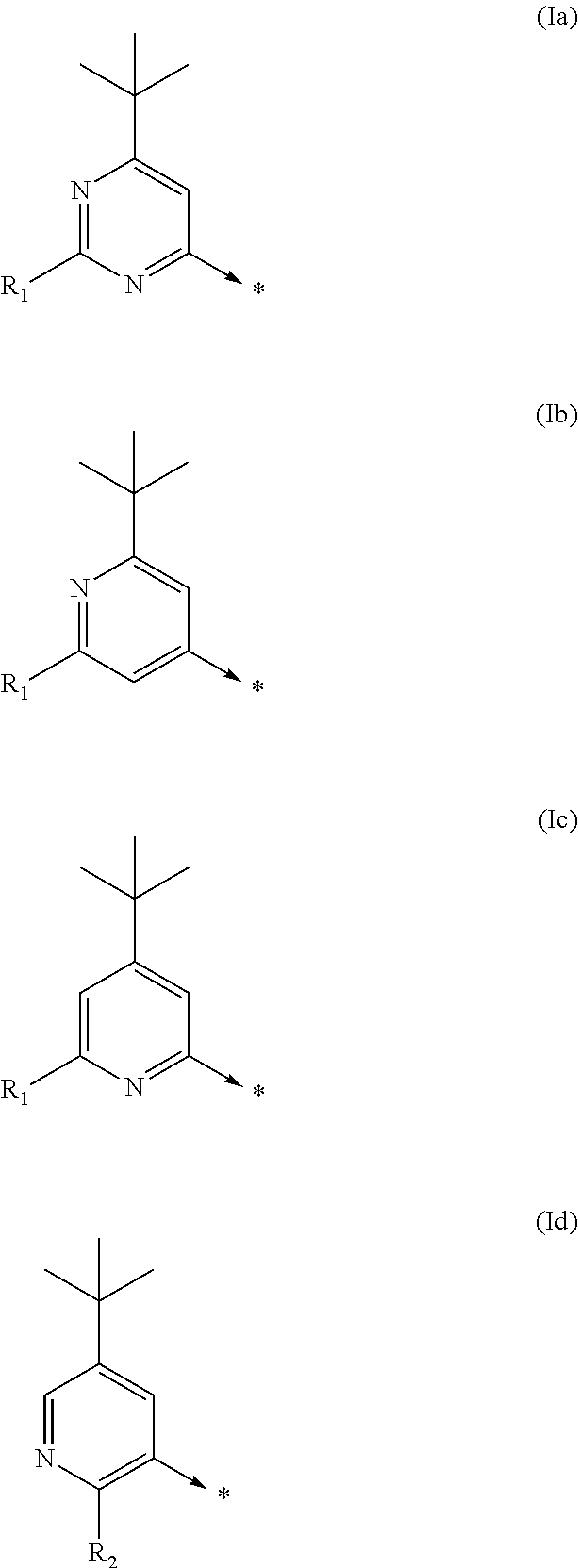Kinase inhibitors
a kinase inhibitor and inhibitor technology, applied in the field of kinase inhibitors, can solve the problems of tnf can be lethal, inflammation within the lung environment, cachexia and anorexia, etc., and achieve the effect of limiting side effects, appropriate inhalatory developability profile, and effective treatment of respiratory obstructive or inflammatory diseases
- Summary
- Abstract
- Description
- Claims
- Application Information
AI Technical Summary
Benefits of technology
Problems solved by technology
Method used
Image
Examples
example 1.4
Example 1. 4-(tert-Butyl)-6-(3-((1S,4R)-4-((3-(tert-butyl)-[1,2,4]triazolo[4,3-a]pyridin-6-yl)oxy)-1,2,3,4-tetrahydronaphthalen-1-yl)ureido)-N-(2-(dimethylamino)ethyl)-pyrimidine-2-carboxamide
[0442]
a. 3-(tert-Butyl)isoxazol-5-amine (Intermediate 1a)
[0443]
[0444]A solution of sodium hydroxide (250 g, 6.25 mol) in water (1250 ml) was added with pivaloylacetonitrile (CAS: 59997-51-2, 250 g, 2.0 mol) followed by hydroxylamine hydrochloride (150 g, 2.16 mol). The mixture was heated to 60° C. during which time it became homogeneous and then began to deposit a solid. After 3 h the mixture was cooled to RT and the solid removed by filtration, washed well with water and dried at 45° C. under vacuum to give the title compound (245.1 g, 88%). The aqueous filtrate was extracted with DCM (2×100 ml) and the combined DCM layers were dried (Na2SO4) and evaporated. (10.9 g, 4%).
[0445]1H NMR (300 MHz, CDCl3) 1.28 (9H, s), 4.31 (2H, br s), 5.03 (1H, s).
b. Ethyl 2-((3-(tert-butyl)isoxazol-5-yl)amino)-2-...
example 1
j. Example 1
[0470]A solution of Intermediate 1i (2.8 g, 4.79 mmol) and N,N-dimethylethylenediamine (2.1 g, 23.9 mmol) in MeOH (30 ml) was heated to 55° C. and stirred for 18 h. The RM was evaporated and the residue partitioned between water and EtOAc. The two phases were separated and the organic layer extracted into 10% citric acid solution. The citric acid layer was washed with Et2O and basified with solid K2CO3 extracting into DCM. The DCM layer was dried (Na2SO4) and evaporated to give the title compound (2.8 g, 93%).
[0471]LCMS (Method 3): Rt 3.29 min, m / z 628.3 [MH+]. 1H NMR (300 MHz, CDCl3): 1.31 (9H, s), 1.53 (9H, s), 1.91-2.28 (10H, m), 2.39 (2H, t, J=6.6 Hz), 3.28-3.40 (2H, m, peak partially obscured by solvent), 4.95-5.04 (1H, m), 5.64 (1H, t, J=3.8 Hz), 7.28-7.47 (5H, m), 7.73-7.76 (2H, m), 8.15 (1H, d, J=1.3 Hz), 8.25 (1H, br s), 8.58 (1H, t, J=5.7 Hz), 9.90 (1H, br s).
example 2.4
Example 2. 4-(tert-Butyl)-N-(2-((2-hydroxyethyl)(methyl)amino)ethyl)-6-(3-((1S,4R)-4-((3-(tert-pentyl)-[1,2,4]triazolo[4,3-a]pyridin-6-yl)oxy)-1,2,3,4-tetrahydronaphthalen-1-yl)ureido)pyrimidine-2-carboxamide
[0472]
a. N′-(5-Fluoropyridin-2-yl)-2,2-dimethylbutanehydrazide (Intermediate 2a)
[0473]
[0474]A solution of (5-fluoro-pyridin-2-yl)-hydrazine (WO 2014 / 195402, which is incorporated herein by reference in its entirety, 40.6 g, 320 mmol) and HOBt (4.34 g, 32 mmol) in DCM (440 ml) was cooled down to 0° C. and then treated with 2,2-dimethylbutanoic acid (40 mL, 320 mmol). EDC (76.7 g, 400 mmol) was added slowly to the reaction, which was left to stir at 0° C. for 30 minutes and then 90 minutes at RT. The reaction mixture was diluted with DCM (100 mL) and washed with brine (100 mL). The organic phase was dried with Na2SO4. The solvent was removed under reduced pressure and the residue was triturated with Et2O, filtered and dried to give the title compound (57.7 g, 80%).
[0475]1H NMR (30...
PUM
| Property | Measurement | Unit |
|---|---|---|
| mass median aerodynamic diameter | aaaaa | aaaaa |
| temperatures | aaaaa | aaaaa |
| temperatures | aaaaa | aaaaa |
Abstract
Description
Claims
Application Information
 Login to View More
Login to View More - R&D
- Intellectual Property
- Life Sciences
- Materials
- Tech Scout
- Unparalleled Data Quality
- Higher Quality Content
- 60% Fewer Hallucinations
Browse by: Latest US Patents, China's latest patents, Technical Efficacy Thesaurus, Application Domain, Technology Topic, Popular Technical Reports.
© 2025 PatSnap. All rights reserved.Legal|Privacy policy|Modern Slavery Act Transparency Statement|Sitemap|About US| Contact US: help@patsnap.com



